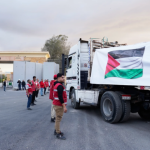
Russia’s Crackdown Forces Central Asia to Rethink Labor Migration
By Andrei Matveev
The most recent World Bank study on labor migration highlighted the immense scale of the issue, describing it as “an ongoing development challenge in Europe and Central Asia, which is currently home to 100 million migrants,” roughly one-third of all migrants globally. Historically, Russia has been the primary destination for Central Asia’s mobile labor force. However, since March 2024, Moscow’s increasingly restrictive migration policies have forced Central Asian states to confront a dual challenge: managing displaced workers and rethinking the logistics of cross-border labor flows.
As of 2023, more than 80% of labor migrants from Tajikistan and Kyrgyzstan were working in Russia. Migration from Uzbekistan was more diversified, with 57% of migrants heading to Russia, 15% to Kazakhstan, and 10% to Ukraine.
For millions across the region, labor migration remains a vital economic lifeline. According to the World Bank report, The Journey Ahead: Supporting Successful Migration in Europe and Central Asia, remittances in 2024 accounted for 45% of Tajikistan’s GDP, the highest ratio globally. In Kyrgyzstan, remittances made up 24% of GDP, while in Uzbekistan the figure was 14%. A 2025 update increased the figure for Tajikistan further still, noting that domestic consumption was “supported by large remittance inflows – peaking at 49% of GDP in 2024.”
Since the start of the war in Ukraine, rhetoric in the Russian media and among some politicians toward Central Asian migrants has increasingly shifted toward overt hostility. Following the March 2024 terrorist attack at Moscow’s Crocus City Hall, in which Tajik nationals were named among the suspects, Russia began implementing harsher measures. This included widespread street inspections of Kyrgyz, Uzbek, and Tajik citizens, alongside new, more restrictive legal frameworks.
While certain steps, such as mandatory biometric data collection, were officially justified by security concerns, other policies have further complicated daily life for foreign nationals. For example, since January 2025, all foreign-owned SIM cards in Russia have been deactivated. Foreign citizens must now register with government agencies to obtain new mobile services, a policy framed as a response to telecom fraud.
Another measure, introduced on June 30, requires citizens of visa-free countries to register in the “Gosuslugi RuID” app before entering Russia. They must obtain a digital code to pass border control, effectively instituting a pre-entry surveillance mechanism.
Kazakhstan was the first to publicly respond, with Foreign Ministry spokesman Aibek Smadiyarov refusing to rule out reciprocal measures against Russian citizens. “We are studying this issue very carefully. It requires consultations with our government agencies,” Smadiyarov said.
Yet, despite these developments, none of the Central Asian countries currently maintains a comprehensive migration strategy equipped to handle these shifting dynamics. In Kazakhstan, the issue came to the fore in 2025 with a noticeable influx of Tajik nationals, the group most affected by Russia’s new rules.
At a government meeting in late July, officials noted that Kazakhstan had recorded a positive migration balance for the second consecutive year, as well as a 1.5-fold increase in the number of foreign citizens permanently residing in the country.
“The importance of transparent and accurate monitoring of migration processes was emphasized,” the Prime Minister’s press service reported. “A migrant ID card will be introduced at border crossings, enabling comprehensive tracking of foreigners’ movements.”
By November 1, the Ministries of Labor and Social Protection, Digital Development, and Aerospace Industry have been tasked with launching a Unified Digital Platform for Migration Monitoring. The new digital card appears to be Kazakhstan’s implicit response to Russia’s shifting migration regime.
Uzbekistan, however, has taken a different approach. In August 2025, in partnership with the European Union and the International Centre for Migration Policy Development, a Migrant Resource Center was opened in Tashkent. The facility offers pre-departure consultations, information on legal employment opportunities, and reintegration support for returning workers. Tashkent is also actively seeking to redirect labor flows away from Russia and toward Europe.
In contrast, Kyrgyzstan and Tajikistan are still assessing the potential fallout. In Kyrgyzstan, returning migrants have already clashed with incoming workers from Pakistan and Bangladesh, raising tensions on the local labor market. Tajikistan has announced a “Migration Regulation Strategy until 2040,” though its specifics remain undisclosed. The long timeframe suggests a low level of urgency in planning for the return or reintegration of its labor force.
Observers across Kazakhstan, meanwhile, have reported a visible increase in Tajik nationals settling in major cities, a trend likely to continue if Russia maintains its current course.
Once a lifeline for three of Central Asia’s five republics, labor migration to Russia is now under increasing strain, pressuring governments to rethink economic dependencies and migration strategies amid a rapidly shifting geopolitical landscape.






![Pakistan accuses the TTP of carrying out attacks on its territory and the Afghan Taliban government of harbouring the group [File: Fayaz Aziz/Reuters]](https://asiandiplomacy.com/wp-content/uploads/2025/10/2023-02-27T041341Z_1777986366_RC2O7Z9GI1FB_RTRMADP_3_PAKISTAN-BLAST-POLICE-1760256429-150x150.webp)